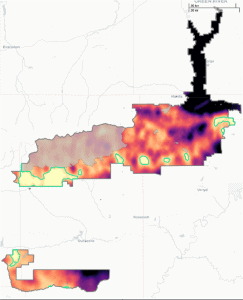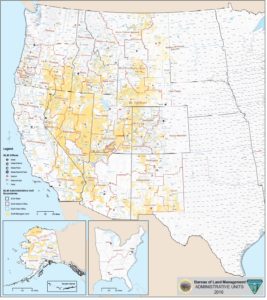The last “weekly” we received was January 18, so I’ll try to fill in the gap (but mostly not today)
The Forest Service summaries are here: Litigation Weekly February 18 2022 Final
Links are to court documents.
COURT DECISIONS
Mountain Communities for Fire Safety v. Elliott (9th Cir.) — On February 4, 2022, the 9th Circuit Court of Appeals issued a favorable decision to the Forest Service allowing use of categorial exclusion 6 for thinning of larger commercially viable trees to reduce fire hazard for the Cuddy Valley Project on the Los Padres National Forest. The court also found the project was consistent with forest plan aesthetic management standards.
Los Padres Forest Watch v. Forest Service (9th Cir.) — On February 4, 2022, the 9th Circuit Court of Appeals issued a mixed decision to the Forest Service regarding the Tecuya Ridge Shaded Fuel-break Project on the Los Padres National Forest. It ruled that the use of CE-6 was proper but that the Forest had not provided adequate substantiation for its determination that 21-inch diameter trees are “generally small diameter timber” within the project area, as required to meet the exception in the Roadless Area Conservation Rule. The court also found that the Forest Service was not arbitrary or capricious, based on the rationale it provided, for choosing to locate part of the project outside of the “threat zone” in the Mt. Pinos Community Wildfire Protection Plan. While there was no violation of ESA, the plaintiffs say the ruling protects 1,100 acres of old-growth forest that is actively used by endangered California condors.
Klamath-Siskiyou Wildlands v. Grantham (E.D. Cal.) — On February 9, 2022, the Eastern District Court of California issued a favorable decision to the Forest Service regarding the Seiad-Horse Risk Reduction Project on the Klamath National Forest. The court upheld the decision to not prepare an EIS based on effects on connectivity, scenery, recreation and roadless area values. It found compliance with the Northwest Forest Plan’s snag retention requirements and its Aquatic Conservation Strategy objectives for water quality, sediment, and in-stream flows. In the latter case, it found that the Forest Service adequately explained how short-term adverse effects would be outweighed by improvements due to riparian planting and large wood placement, and it adequately explained how the impacts would fall with the natural range of variability for water quality, sedimentation, and stream flows.
NEW CASES
New Mexico Cattle Growers’ Association v. Vilsack (D. N.M.) — On February 9, 2022, the plaintiff filed a complaint in the District Court of New Mexico against the Forest Service and Animal and Plant Health Inspection Service for violating numerous requirements in permitting the use of helicopters to shoot feral cattle on the Gila National Forest within the Gila Wilderness. A temporary restraining order was denied. At least 67 unbranded cattle have been killed so far.
Cottonwood Environmental Law Center v. Erickson (D. Mont.) — On February 4, 2022, the plaintiff filed a complaint against the Forest Service for violating the National Environmental Policy Act with regard to the effects of the 2022 Revised Custer Gallatin Land Management Plan on the Custer Gallatin National Forest and three “old growth timber sales” in conjunction with climate change. The Plaintiff specifically objects to failure to consider a 2017 National Academy of Sciences article stating, “when thinning is combined with the expected warming, unintended consequences may ensue, whereby regeneration is compromised and forested areas convert to nonforest.”
OTHER AGENCY CASES
Appalachian Voices v. U.S. DOI (4th Cir.) — On February 3, 2022, the 4th Circuit Court of Appeals held that the U.S. Fish and Wildlife Service had violated the ESA with regard to its biological opinion and Incidental Take Statement for the Mountain Valley Pipeline. The FWS failed to adequately evaluate the environmental baseline and impacts of climate change on the Roanoke logperch and the candy darter. (See more on the Mountain Valley Pipeline below)
Cascadia Wildlands v. U.S. Bureau of Land Management (D. Oregon) — On February 8, 2022, the plaintiffs filed a complaint in the District Court of Oregon challenging the U.S. Bureau of Land Management’s authorization of the Archie Creek Fire Salvage Harvest and Hazard Tree Removal Project in late successional reserves in the North Umpqua Watershed in Oregon. Some additional background is here.
BLOGGER’S BONUS
Wild Virginia v. U. S. Forest Service (4th Cir.)
The court decision against the Mountain Valley Pipeline above was the second this year. On January 25, the Fourth Circuit Court of Appeals found that the Forest Service had violated NEPA and NFMA when it amended the Jefferson National Forest Plan to except this project from 11 forest plan standards (the second time these amendments had been reversed).
With regard to NEPA, the Forest Service did not adequately consider sedimentation and erosion impacts because it failed to address USGS monitoring data on effects of the pipeline outside of the national forest showing water turbidity values that were 20% higher downstream from the Pipeline’s construction than upstream — a significant difference from the 2.1% increase in sedimentation the hydrologic analyses used in the EIS predicted. It also improperly authorized the use of a conventional bore method of crossing streams that had not yet been evaluated by FERC in their EIS.
The court also found that the amendment violated 2012 Planning Rule requirements that a forest plan “must include . . . components . . . to maintain or restore the ecological integrity of terrestrial and aquatic ecosystems and watersheds in the plan area” (emphasis supplied by the court). This followed from the failure to adequately assess the impacts of the Pipeline on sedimentation, which is necessary to demonstrate that they would comply with the specific language of the substantive regulatory requirement (rather than a generic conclusory statement).
This article includes a chronology and some maps.




